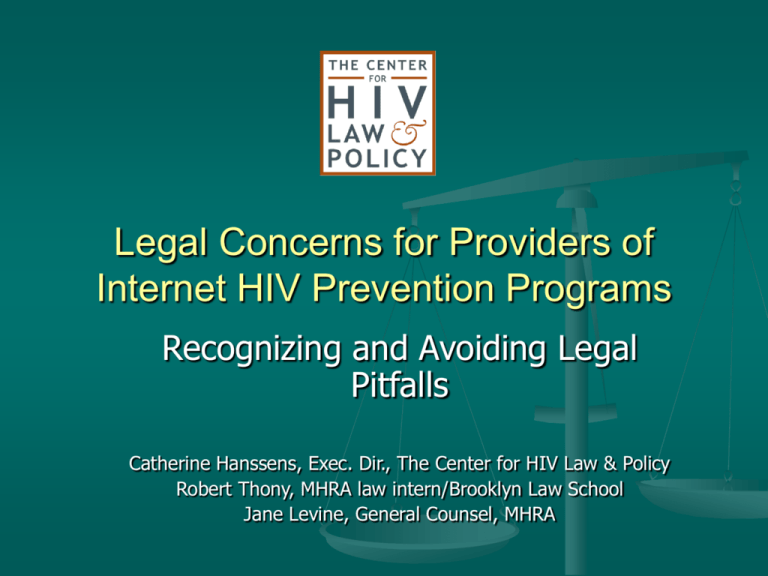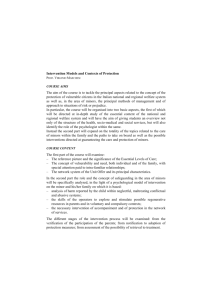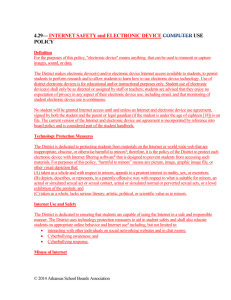
Legal Concerns for Providers of
Internet HIV Prevention Programs
Recognizing and Avoiding Legal
Pitfalls
Catherine Hanssens, Exec. Dir., The Center for HIV Law & Policy
Robert Thony, MHRA law intern/Brooklyn Law School
Jane Levine, General Counsel, MHRA
NEED –
INTRODUCTION
Sexual health understanding is key to healthy adulthood
Kids have uneven access to sound sexual health education in
schools
Kids become sexual before 16; turn to internet for
information
* Study: 72% of adolescents said they used the Internet in their
own home, 17% in school, 4% at a friend’s, and 6% at other
locations.
* 63% of respondents obtained info on birth control and safer sex
from friends; 32% from siblings or cousins; 31% from the Internet;
31% from magazines; 29% from parents; 29% from health care
providers or clinics; 21% from health class; 17% from teachers or
coaches; 9.5% from public health campaigns; and 3.6% from
clergy. (D. Borzekowsi, Ed.D. and V. Rickert, Psy.D., “Adolescent
Cybersurfing for Health Information,” Archives of Pediatric and
Adolescent Medicine, vol. 155, July 2001)
RISKS –
Exposure to distressing characterizations of sex, sexuality, risk of
pedophilia or exploitation; misunderstandings concerning depictions and
discussions of sexuality and sexual behavior.
Prosecution if there is an “incident” and you’ve allegedly stepped over
the line
Loss of funding due to federal restrictions (e.g., CDC inquiries such as
that into StopAIDS, based on allegations that the group used federal
money to support HIV/AIDS awareness programs—such as its "Booty
Call" and "Great Sex" workshops—that encourage sexual activity and
violate federal obscenity standards.)
RIGHTS –
Federal case law is clear that especially in the areas of reproductive
health -- pregnancy, abortion and sexually-transmitted disease
prevention -- juveniles hold fundamental privacy rights to choose their
care despite their age.
In order to effectively exercise these rights, adolescents must have
access to complete and science-based sexual health information and
services.
STEP ONE: DEFINING TERMS
When is sexual information educational, and
when is it obscene or pornographic?
►Obscene? US Supreme Ct’s three-part test:
Does material depict or describe specific sexual activities
or organs in a “patently offensive” manner?
Would average person, applying “contemporary
community standards,” find that the material taken as a
whole appeals predominantly to a “prurient interest”
(shameful, morbid) in sex?
Does material, taken as a whole, lack “serious literary,
artistic, political, or scientific value”?
When is sexual material “harmful to minors”?
NY: any description or representation, in whatever form, of nudity,
sexual conduct, sexual excitement, or sado-masochistic abuse,
when it:
(a) Considered as a whole, appeals to the prurient interest in sex of
minors; and
(b) Is patently offensive to prevailing standards in the adult community
as a whole with respect to what is suitable material for minors; and
(c) Considered as a whole, lacks serious literary, artistic, political and
scientific value for minors.
Child pornography and “harmful to minors” law are sometimes
confused, but legal standards and rationales are quite different
Child pornography laws are intended to protect children from
physical harm; “harmful to minors” laws govern what youth see or
listen to
ENTER THE INTERNET
THE ARRIVAL AND EXTRAORDINARY GROWTH
OF THE INTERNET HAS RAISED QUESTIONS
(AND CONFUSION) ABOUT LEGAL RULES ON
SEXUAL EXPRESSION
WHAT DOES “COMMUNITY STANDARDS” MEAN
IN CYBERSPACE?
HOW DO WEB-BASED PROGRAMS DISTINGUISH
BETWEEN MINORS AND ADULTS?
STEP TWO: KNOWING THE LAW
What laws, cases, guidelines and restrictions
define the parameters of acceptable online sex
education?
Relevant New York law
Disseminating indecent material to minors in the first
degree:
A person is guilty of disseminating indecent material to minors in
the first degree when:
1. An adult computer communication with a minor involves words or
images of actual or simulated nudity, sexual conduct or
sadomasochistic abuse which is harmful to minors, he intentionally
uses any computer communication system to initiate or engage in
such communication with a person who is a minor; and
2. is used to invites or induces a minor to engage in sexual conduct
or sexual contact with him, or to engage in a sexual performance
for his benefit.
Relevant New York law (continued)
Disseminating indecent material to minors in the second
degree:
A person is guilty of disseminating indecent material to
minors in the second degree when:
1. he sells or loans to a minor for monetary
consideration:
(a) Any visual representation of a person which depicts
nudity, sexual conduct or sado-masochistic abuse and which
is harmful to minors; or
(b) Any printed matter however reproduced, or sound
recording which contains any matter enumerated in
paragraph (a) hereof, or explicit and detailed verbal
descriptions or narrative accounts of sexual excitement,
sexual conduct or sado-masochistic abuse and which, taken
as a whole, is harmful to minors; or
Relevant New York law (continued)
Disseminating indecent material to minors in the second
degree (continued):
2. Knowing a motion picture, show or other presentation depicts
nudity, sexual conduct or sado-masochistic abuse, and which is
harmful to minors, he:
(a) Exhibits it to a minor for a monetary consideration; or
(b) Sells a minor an admission ticket or pass to premises
where it’s exhibited; or
(c) Admits a minor for a monetary consideration to premises
whereon there is exhibited or to be exhibited such motion picture
show or other presentation; or
3. Knowing the character and content of the communication which,
in whole or in part, depicts actual or simulated nudity, sexual
conduct or sado-masochistic abuse, and which is harmful to minors,
he intentionally uses any computer communication system
allowing the input, output, examination or transfer, of computer
data or computer programs from one computer to another, to
initiate or engage in such communication with a person
who is a minor.
STEP TWO: KNOWING THE LAW
What laws, cases, guidelines and restrictions
define the parameters of acceptable online sex
education?
What the U.S. Supreme Court has to say:
Stanley v. Georgia (1969)
Right to own and view sexually explicit (even obscene)
materials in the privacy of one’s home.
Only exception recognized since is child pornography.
Compelling state interest in protecting kids from sexual
exploitation; ownership of child porn = crime.
Lawrence v. Texas (2006)
Private consensual adult sexual activity is constitutionally
protected
STEP TWO: KNOWING THE LAW
What’s the battle between Congress and Free
Speech/Sex Positive Advocates About?
Much of the debate and legislation concerning censorship of the internet is
centered on efforts to protect minors from sexually explicit content. The
Communications Decency Act (1996), the Child Online Protection Act
(1998), and the Children's Internet Protection Act (2000) are examples of
Internet legislation, and each has been challenged under the First
Amendment.
In February of 1996, Congress enacted the Communications Decency Act
(CDA). CDA sought to protect minors from harmful material online by
criminalizing transmission of “indecent” materials to minors. However, in
1997, the Supreme Court ruled 9-0 in Reno v. American Civil Liberties Union
that CDA was an unconstitutional restriction on the Internet, which they
called a “unique and wholly new medium of worldwide human
communication” deserving of full First Amendment protection.
Many opponents of CDA pointed to impact it would have on minors’ access
to HIV, STD, and drug abuse prevention, as well as birth control and other
health issues if they were required to identify themselves
STEP TWO: KNOWING THE LAW
What laws, cases, guidelines and restrictions define the
parameters of acceptable online sex education?
Relevant Federal law
Children’s Internet Protection Act (CIPA) – all schools and libraries
receiving federal aid for Internet connections must install a
“technology protection measure” (filter) on all computers, whether
used by minors or adults that screens out images that are “obscene,”
“child pornography,” or “harmful to minors”
In 2003, the Supreme Court ruled to allow implementation of the
Children’s Internet Protection Act (CIPA), which required that filters be
placed to limit the content available on library computers.
Unfortunately, these regulations have unexpected consequences - for
example, that the filters often inadvertently block indisputably
acceptable speech.
FCC censorship power over “indecent” speech applies only to
broadcasting; government cannot block “patently offensive” or
“indecent” expression on the Internet or in print media
STEP TWO: KNOWING THE LAW
What laws, cases, guidelines and restrictions define the
parameters of acceptable online sex education?
What the federal courts have to say:
COPA (Child Online Protection Act) (still blocked by federal courts) –
criminalizes Internet transmission of sexually explicit materials and
communications that are available to and harmful to minors
Ashcroft v. American Civil Liberties Union (2004) DOH failed to show
Gonzales v. Google (2006)
American Civil Liberties Union v. Gonzales (2007): COPA is not
that COPA is the least restrictive way to accomplish legitimate goal of
protecting minors, so injunction against COPA implementation stands.
Rejection of the government’s demand for millions of Google search
records, that the government claimed were needed to defend COPA
against the challenge in Ashcroft v. ACLU. The government failed to
describe how the millions of Google user records will help it to determine
how much material deemed “harmful to minors” is available online.
narrowly tailored to the compelling interest of protecting minors –
unconstitutionally vague and overbroad
STEP TWO: KNOWING THE LAW
What laws, cases, guidelines and restrictions define the
parameters of acceptable online sex education?
What the federal courts have to say:
“Section 2257” (amended Fed’l Recordkeeping and Label Act – universal
age verification requirement)
Connection Distributing Co. v. Keisler (Oct.2007)
Federal appeals court strikes down federal law that would have
required every producer of sexually-explicit images to maintain
detailed proof-of-age and identity records open to government
inspection as an overbroad attempt to crack down on child porn.
Court focused on law’s impact on non-commercial producers of
sexually explicit images.
Example of ruling on state statute criminalizing transfer to minor of
sexually explicit materials “harmful to minors”:
American Booksellers Foundation v. Dean (2nd Cir. 2003)
Vt. State law violated 1st Amendment rights of web site operators
providing sexual health advice; goal of preventing pedophiles from
“grooming” minors for future sex encounters effectively addressed
via statutes regulating electronic luring.
CDC HIV Prevention Funding
Requirements
From the CDC:
“The HIV Content Guidelines ensure that HIV prevention materials
contain messages on ways by which individuals can protect
themselves from acquiring the virus or reduce their risk of acquiring
or spreading the virus.
The Guidelines provide a framework for developing and using
educational materials and require that Program Review Panels
(PRPs) consider the appropriateness of messages designed for
various groups.
According to the Guidelines, the PRPs must be composed of at least
5 members, include at least one employee of the state or local
health department, and represent a reasonable cross-section of the
general population.”
REQUIREMENTS FOR CONTENTS OF AIDS-RELATED WRITTEN
MATERIALS, PICTORIALS,
AUDIOVISUALS, QUESTIONNAIRES, SURVEY INSTRUMENTS,
AND EDUCATIONAL SESSIONS IN
CENTERS FOR DISEASE CONTROL AND PREVENTION (CDC)
ASSISTANCE PROGRAMS
All programs must include info about the “harmful effects of
promiscuous sexual activity and intravenous substance abuse”
No funds can be used to “promote or encourage, directly,
homosexual or heterosexual sexual activity or intravenous substance
abuse.”
Not intended to restrict the ability of a program to provide accurate
information about various means to reduce an individual’s risk of
exposure to, or transmission of, HIV as long as materials are not
obscene
Programs shouldn’t include activities in which attendees participate
in sexually suggestive physical contact or actual sex.
Message for adolescents in schools “and in other settings” should be
guided by “Guidelines for Effective School Health Education to
Prevent the Spread of AIDS” (MMWR 1988:37 [suppl. No. S-2]
REQUIREMENTS FOR CONTENTS OF AIDS-RELATED
WRITTEN MATERIALS, PICTORIALS,
AUDIOVISUALS, QUESTIONNAIRES, SURVEY
INSTRUMENTS, AND EDUCATIONAL SESSIONS IN
CENTERS FOR DISEASE CONTROL AND PREVENTION
(CDC) ASSISTANCE PROGRAMS
Grantees must agree in writing to comply with the Requirements for
Contents of AIDS-Related Written Materials, Pictorials, Audiovisuals,
Questionnaires, Survey Instruments, and Educational Sessions in
Centers for Disease Control and Prevention (CDC) Assistance
Programs," as revised June 15, 1992, 57 Federal Register 26742.
All program written program materials, including questionnaires,
survey instruments, proposed group educational sessions,
educational curricula and like materials must be submitted to a
Program Review Panel before use.
The Program Review Panel reviews and approve all applicable
materials prior to their distribution and use in any activities funded
in any part with CDC funds.
STEP THREE:
Putting Protections in Place
Expert/Ethics review committees to:
Avoiding transmission of
obscene/indecent material to minors
and others
Ensuring accuracy and balance of
material – no excuse for inaccurate
information!
Procedures for when other adults should
be present
STEP THREE:
Putting Protections in Place
Informed consent & age issues
ACLU v. Gonzales, 3/2007:
“On the Internet, everyone is faceless and fairly anonymous and
thus…the Internet merchant has no viable method of determining
whether an individual is 6, 12, 17 or 51 years old…
…a story that might have ‘serious literary value’ for a 16-year-old
could be considered to appeal to the “prurient interest” of an 8year-old and be ‘patently offensive’ and ‘without serious value’ to
that child.”
In short, it is overly burdensome, if not impossible, to verify the age
of site visitors or limit access to young/some minors without limiting
to all.
STEP THREE:
Putting Protections in Place
Confidentiality: clearly explain
privacy policy; do not collect minor’s
identifiable personal information
online.
Website Disclaimers/Disclosures …
Sample Website
Disclaimers/Disclosures: WebMD
Message Boards and other Public Forums
“As a service to our users [this site] feature message boards, chat
rooms and other public forums where users with similar interests or
medical conditions can share information and support one another or
where users can post questions for experts to answer. We also offer
online discussions moderated by medical or healthcare experts. Any
information shared (including Personally Identifiable and
Personal Health Information) that you reveal in a chat room,
message board, Ask Our Expert posting or online discussion
such as WebMD University is by design open to the public and
is not a private, secure service. You should think carefully
before disclosing any Personally Identifiable or Personal Health
Information in any public forum. What you have written may
be seen, disclosed to or collected by third parties and may be
used by others in ways we are unable to control or predict,
including to contact you for unauthorized purposes. As with
any public forum on any site, this information may also appear
in third-party search engines like Google, Yahoo, MSN etc.”
Sample Website
Disclaimers/Disclosures: WebMD
Children
“We are committed to protecting the privacy of children. Neither
WebMD Health nor any of its services are designed or intended
to attract children under the age of 13. We do not collect
Personally Identifiable Information from any person we actually
know is under the age of 13. A parent or guardian, however,
may use WebMD Health Manager to establish a personal health
record and a WebMD Health Manager home page for a minor.
The parent or guardian is solely responsible for providing
supervision of the minor's use of WebMD Health Manager. The
parent or guardian assumes full responsibility for ensuring that
the registration information is kept secure and that the
information submitted is accurate. The parent or guardian also
assumes full responsibility for the interpretation and use of any
information or suggestions provided through WebMD Health
Manager for the minor.”
DUTY TO WARN?
What if a client informs a staff member of his/her involvement in
dangerous/illegal activity?
The law in the internet context is no different –
Is the staffer in a therapeutic relationship with the client, and is the client making a credible
threat of severe bodily harm to an identifiable third party who likely is unaware of the threat?
Unlikely that staffer will have the relationship or the info to trigger a duty to warn.
Does Article 27F (NY HIV confidentiality law) apply – e.g., does the staffer work for a covered
entity that acquires HIV-related information in the course of providing services?
Under NY law, a physician may disclose the HIV status of an index patient to a sex and/or
needle sharing partner only under specific conditions, i.e., it’s clear that dislosure is:
medically appropriate
there is significant risk of HIV transmission to the partner
the index patient has been has been counseled but won’t tell
The patient has been warned of 3rd-party notificaiton and given a final
choice to notify partner



